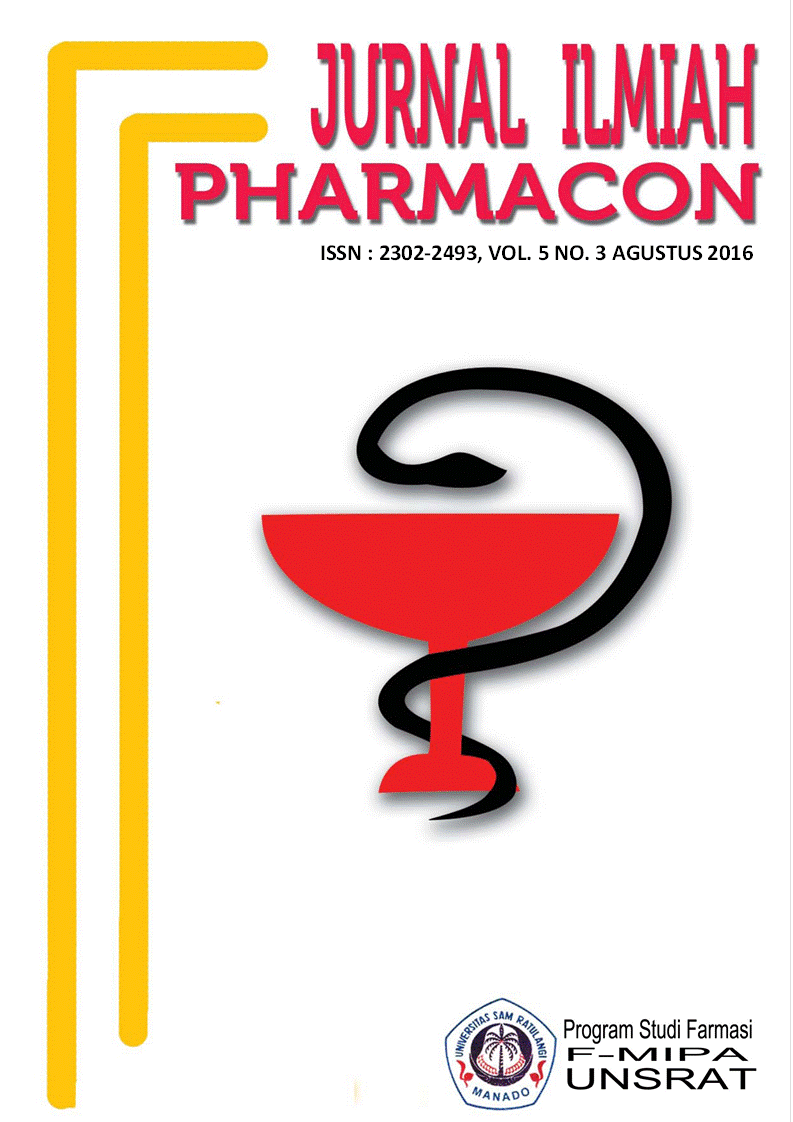FORMULASI DAN PENGUJIAN AKTIVITAS ANTIBAKTERI SABUN CAIR EKSTRAK ETANOL DAUN EKOR KUCING (Acalypha hispida Burm.F) TERHADAP PERTUMBUHAN BAKTERI Staphylococcus aureus
DOI:
https://doi.org/10.35799/pha.5.2016.12936Abstract
FORMULASI DAN PENGUJIAN AKTIVITAS ANTIBAKTERI SABUN CAIR EKSTRAK ETANOL DAUN EKOR KUCING Â Â Â Â Â Â Â Â Â Â Â Â Â Â Â Â Â Â Â Â Â Â Â Â Â Â (Acalypha hispida Burm.F) TERHADAP PERTUMBUHAN BAKTERI Staphylococcus aureus
Jessica Ch. Kasenda1), Paulina V.Y.YamLean1), Widya Astuty Lolo1)
1)Program Studi Farmasi FMIPA UNSRAT Manado,95115
Â
ABSTRACT
Ekor kucing leaves (Acalypha hispida) has an antibacterial activity. Chemical compound as an antibacterial in Ekor Kucing are tannins, flavonoids, saponins and acalypin. This research aims to make formulation dosage of antibacterial liquid soap of the Ekor kucing leaves ethanol extract, testing the quality of Ekor kucing leaves ethanol extract liquid soap and testing activity of antibacterial of Ekor kucing leaves ethanol extract liquid soap with concentration of 3%, 6% and 9% to Staphylococcus aureus bacteria growth. Organoleptic test, pH test, high foam, water content, alkali-free and specific gravity test were done in liquid soap formulation of ethanol extract of Ekor kucing leaves with a concentration of 3%, 6% and 9%. Testing of antibacterial activity against Staphylococcus aureus growth was conducted by diffusion. Results of the quality test of the liquid soap meets the requirements according to the standards set by SNI is organoleptic test, pH test, high foam, alkali-free and specific gravity test. The results of antibacterial activity test of liquid soap Ekor Kucing leaves extract can inhibit Staphylococcus aureus, concentration 3% in the category of weak inhibition zone, concentration 6% and 9% in the category medium inhibition zone.
Keywords: Ekor kucing, liquid soap, antibacterial, Staphylococcus aureus.
Â
ABSTRAK
Daun Ekor kucing (Acalypha hispida Burm.F) memiliki aktivitas antibakteri. Kandungan kimia yang terdapat didalamnya yang bersifat antibakteri ialah tanin, flavonoid, saponin dan acalypin. Penelitian ini bertujuan untuk membuat formulasi sediaan sabun cair antibakteri dari ekstrak etanol daun Ekor kucing, menguji mutu dari sabun cair ekstrak etanol daun Ekor kucing dan menguji aktivitas antibakteri sabun cair ekstrak etanol daun Ekor kucing dengan konsentrasi 3%, 6% dan 9% terhadap pertumbuhan bakteri Staphylococcus aureus. Formulasi sabun cair ekstrak etanol daun Ekor kucing dengan konsentrasi 3%, 6% dan 9% dilakukan pengujian organoleptis, pH, tinggi busa, kadar air, alkali bebas dan uji bobot jenis. Pengujian aktivitas antibakteri terhadap pertumbuhan Staphylococcus aureus dilakukan dengan metode difusi. Hasil pengujian mutu sabun cair yang yang memenuhi persyaratan sesuai standar yang ditetapkan SNI ialah uji organoleptis, pH, tinggi busa, alkali bebas dan uji bobot jenis. Hasil uji aktivitas antibakteri sabun cair ekstrak daun Ekor kucing yang diperoleh dapat menghambat bakteri Staphylococcus aureus, yakni dengan konsentrasi 3 % masuk dalam kategori zona hambat yang lemah, konsentrasi 6% dan 9% masuk dalam kategori zona hambat yang sedang.
Kata kunci : Ekor kucing, sabun cair, antibakteri, Staphylococcus aureus.
Â
Â
Â
Downloads
Published
How to Cite
Issue
Section
License
Authors who publish with this journal agree to the following terms:
- Authors retain copyright and grant the journal right of first publication with the work simultaneously licensed under a Creative Commons Attribution-NonCommercial 4.0 International License that allows others to share the work with an acknowledgement of the work's authorship and initial publication in this journal.
- Authors are permitted and encouraged to post their work online (e.g., in institutional repositories or on their website) prior to and during the submission process, as it can lead to productive exchanges, as well as earlier and greater citation of published work (See The Effect of Open Access)










